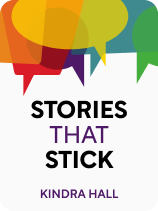

This article is an excerpt from the Shortform book guide to "Stories That Stick" by Kindra Hall. Shortform has the world's best summaries and analyses of books you should be reading.
Like this article? Sign up for a free trial here.
Do you have trouble connecting to your audience? What are the different types of stories you can use to attract customers?
It can be intimidating to know how to choose the right story for the right occasion, especially when it comes to marketing. In Stories That Stick, Kindra Hall outlines four core stories that you can swap in depending on your audience and your intended goal.
Below we’ll look at four stories every businessperson should have in their back pocket.
1. The Value Story
The first of the four different types of stories is the Value Story. This is a useful tool when you want to increase sales or market to a new audience. According to Hall, the purpose of the Value Story is to communicate to your audience that you have the answer to their problem. It should articulate how your product or service will change your audience’s life for the better.
(Shortform note: In This Is Marketing, Godin explains that people aren’t looking for a product, but for a feeling that your product or service gives them. So as you’re crafting your value story, think of the problem as what your customer wants to be feeling, but isn’t, and the solution as the feeling your product provides them. For example, if someone wants to feel more adventurous, the answer might be a rugged all-wheel-drive car. That’s the story you have to tell.)
As with all good stories, when you tell a Value Story, follow Hall’s recommended structure—describe the before, the change, and the after. The before should address the problem that your audience is struggling with. The moment of change is when your product or service comes into the picture. Then wrap up your story by describing what happens next—how is life different or better now that your audience has your product or service in hand?
(Shortform note: Not all Value Stories follow Hall’s recommended structure. There are many creative ways to communicate values without telling a traditional story. By using visual elements, slogans, music, or celebrity endorsements, companies can create a memorable and impactful message that resonates with their target audience. For example, in Google’s 2022 “Year in Search” commercial, the company used a compilation of videos to communicate the idea that Google is about imagining what’s possible. The video creates emotional resonance even without following Hall’s recommended story framework.)
The 2019 Subaru Forester commercial, “A Parent’s Imagination,” is an example of a well-told Value Story. The ad begins by showing parents imagining the worst-case scenario of their teenager driving off the road or getting into a car accident because they are texting a friend or eating French fries. The problem: Parents are worried about their kids’ driving. But then, something changes—a distracted teenager is reminded by the Forester’s safety mechanism to “keep your eyes on the road,” allowing them to slam on the brakes just in time. The commercial ends with the child returning safely home and a mother breathing a sigh of relief. The message of the story is clear—you’re worried about your kids’ driving, but with this car, you don’t have to be.
This commercial also includes the four components of a good story—characters the audience can relate to (parents), specific details (parents looking out the window for their kids while washing dishes), strong feelings (anxiety and fear), and a turning point (the moment the car’s safety mechanism engages).
2. The Customer Story
The Customer Story serves much the same purpose as the Value Story. The only difference is that the story is told by the customers, not the company.
Customers’ stories are inherently more reliable than the polished stories produced by companies because they are real and unfiltered. Hall explains that the imperfections are what make the stories credible. The Customer Story can range from reviews posted on your website to interviews with real customers.
(Shortform note: The credibility of the Customer Story has become complicated by the rise of influencer marketing, a type of social media marketing that pays people with a big social media following to promote or endorse a product. Influencers aren’t always upfront or transparent about their paid content. For example, in 2021 Kim Kardashian created an Instagram post that implied her support for EthereumMax (EMAX), a new cryptocurrency. It was later revealed that Kardashian was paid $250,000 for her post. While these sorts of ads are a kind of Customer Story, they aren’t the unfiltered narratives that Hall describes.)
Warby Parker is a brand that strategically relies on customer stories in its marketing. To promote their home and virtual try-on options for glasses, Warby Parker compiled testimonials from real Warby Parker customers. In the videos, customers try on glasses while talking about the experience. The testimonials feel genuine because they are natural and unrehearsed. The cumulation of these testimonials tells the story that Warby Parker wants to tell—we make buying glasses easier.
Hall cautions that customer stories can be challenging because they’re harder to find and you have less control of the narrative. However, while you can’t control what customers say, you can strategically guide them to shape their testimonials into stories. For example, in the case of Warby Parker, the company might ask customers to talk about their previous experience buying glasses (the before) and then explain how Warby Parker is different (the change and the after).
(Shortform note: To find great customer stories, the US Small Business Association (SBA) recommends starting with your most loyal and long-term customers. Ask them if they’re willing to provide a testimonial. Like Hall, the SBA recommends offering guidance in the form of specific questions and even taking the time to chat on the phone for five- to 10 minutes to help the customer polish their story. Never be afraid to ask your customer to be more specific. The more specific the story, the more effective it will be.)
3. The Founder Story
The Founder Story is useful when you’re courting investors, attracting new customers, or recruiting team members to your organization. According to Hall, the purpose of the Founder Story is to show what makes you stand out from the competition. This is the story of how your company began and the person behind it all. In this case, you’re not selling a product, you’re selling the person behind the company.
The Founder Story is more prescriptive than the other core stories. Your character must be the founder and the story should convey the passion and perseverance of that person. You want your audience to walk away impressed by how hard the founder worked to get where they are.
Procter & Gamble (P&G) is an example of a company that uses its Founder Story to inspire new employees to become more invested in the company and immersed in its culture. For instance, new P&G hires read “The Book,” which describes the company’s history and the founders’ core values, and new employees also take time to visit a life-size marble sculpture of William Cooper Procter, who was responsible for growing the Procter family’s business.
Hall emphasizes that you don’t have to be the founder to tell the Founder Story. If you don’t know your company’s founding story, ask! Then, as you retell it, talk about the first time you heard the founder’s story and how it impacted you. The founder’s story is valuable, regardless of who’s telling it.
4. The Purpose Story
The last of the core stories is the Purpose Story, which is useful when you want to bring people together around a shared vision.
(Shortform note: In First Things First, Stephen R. Covey emphasizes that a shared vision is only impactful if that vision empowers everyone. Before crafting your story, make sure that your vision focuses on a purpose that everyone is passionate about and addresses everyone’s needs, not just the needs of those at the top. No matter how good your story is, if your vision falls short, your story will too.)
Hall argues that storytelling helps align people around a shared purpose in three ways.
- Shared Challenges: A Purpose Story can remind people of their shared humanity, build trust, and open the door to productive dialogue.
- Shared Values: A Purpose Story can help people understand and connect with the values that guide the organization or community.
- Shared Vision: A Purpose Story can help people visualize a shared goal or future.
(Shortform note: While a Purpose Story can be a powerful tool for building unity and alignment around a shared goal, organizations may need to do more to address underlying structural issues or conflicts within an organization. Chronic issues often stem from interconnected issues; additional strategies such as conflict resolution, diversity and inclusion training, and community building may be necessary to create a productive and effective team.)
Patagonia is an example of an organization that uses all three strategies to organize people around a shared purpose. In their marketing, Patagonia communicates the shared challenges of overconsumption and climate change, the shared value of environmental responsibility, and the vision for a more sustainable clothing industry and healthier planet, which all contribute to Patagonia’s higher purpose—to protect the planet (and sell outdoor clothing).
Patagonia aligns people around what neuroeconomist Paul Zak refers to as a “transcendent purpose.” Citing Zak’s research, Hall explains that focusing on a transcendent purpose leads to deeper and more sustained levels of motivation and commitment. Focusing on a transactional purpose (exchange for goods and services), on the other hand, leads to shorter-term motivation and less fulfillment. In short, stories that speak to a deeper purpose are more likely to increase brand loyalty by helping customers develop an identity around your company.
(Shortform note: Research suggests transcendent purpose is especially important in workplace retention. The 2016 Deloitte Millennial Survey found that 87% of millennials believed that “the success of a business should be measured in terms of more than just its financial performance.” This included factors such as environmental sustainability, diversity and inclusion, and ethical business practices. In another study by Deloitte, 70% of millennials listed their company’s commitment to the community as an influence on their decision to work there.)

———End of Preview———
Like what you just read? Read the rest of the world's best book summary and analysis of Kindra Hall's "Stories That Stick" at Shortform.
Here's what you'll find in our full Stories That Stick summary:
- Why stories are probably the answer to most of your business problems
- How to harness the power of storytelling to connect with your audience
- How to integrate storytelling into your marketing strategy






